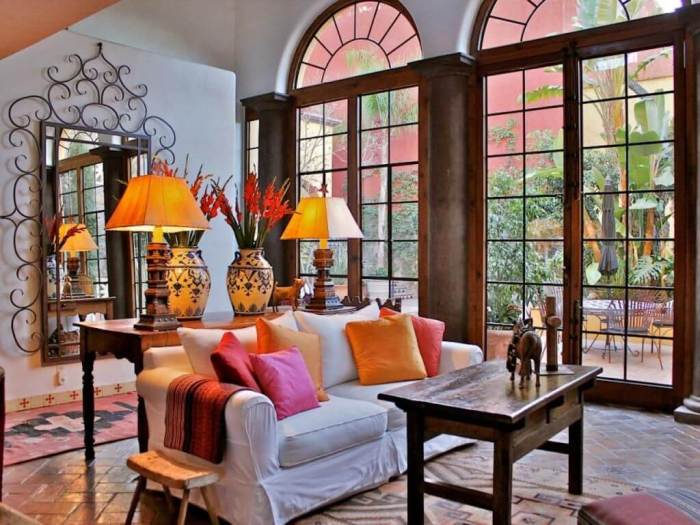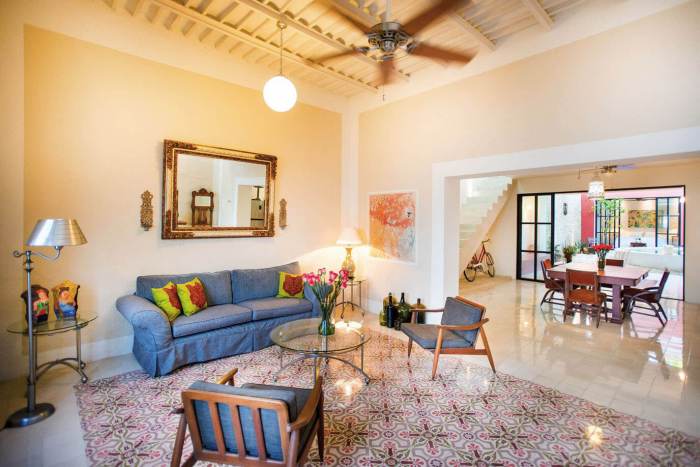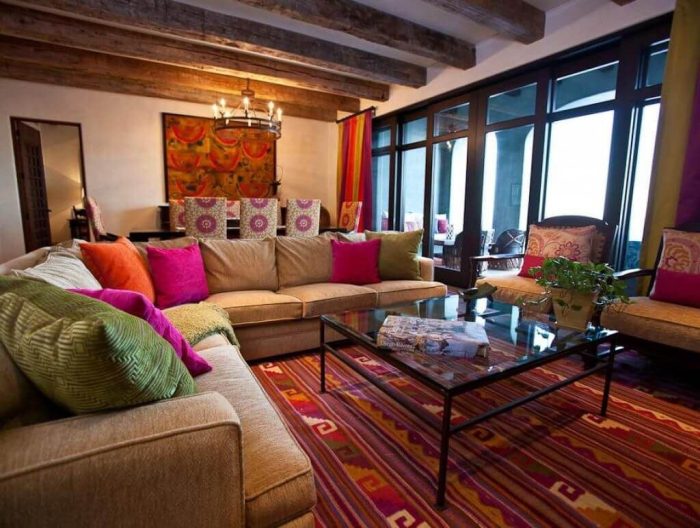Exploring Mexican Interior Design: A Vibrant Fusion of Tradition and Modernity
Mexican interior design sets the stage for this enthralling narrative, offering readers a glimpse into a story that is rich in detail and brimming with originality. From the traditional elements rooted in cultural heritage to the modern trends shaping contemporary spaces, Mexican interior design is a captivating blend of history and innovation.
Overview of Mexican Interior Design
Mexican interior design is characterized by vibrant colors, intricate patterns, and a blend of traditional and contemporary elements. It reflects the rich cultural heritage of Mexico and often incorporates handmade crafts and textiles.
Key Elements of Mexican Interior Design
- Talavera tile: Hand-painted ceramic tiles that add a splash of color to walls and floors.
- Wrought iron elements: Intricate ironwork can be found in light fixtures, furniture, and decorative accents.
- Handcrafted textiles: Colorful rugs, blankets, and pillows made by local artisans are commonly used.
- Wooden furniture: Rustic wooden furniture with carved details is a staple of Mexican design.
Cultural Influences on Mexican Interior Design
Mexican interior design is heavily influenced by the country's history, traditions, and diverse cultural heritage. Pre-Hispanic motifs, Spanish colonial architecture, and indigenous craftsmanship all play a role in shaping the unique aesthetic of Mexican interiors.
Color Schemes in Mexican Interior Design
- Earthy tones: Warm shades of terracotta, mustard yellow, and deep reds are commonly used to create a cozy and inviting atmosphere.
- Bright accents: Vibrant pops of color, such as turquoise, cobalt blue, and fiery orange, are often incorporated to add energy and character to the space.
- Natural elements: Shades of green inspired by Mexico's lush landscapes, along with earthy browns and sandy hues, bring a sense of nature indoors.
Traditional Mexican Interior Design

Traditional Mexican interior design is characterized by its vibrant colors, intricate patterns, and handcrafted furniture. Artisans play a significant role in preserving and promoting this unique style, creating pieces that showcase the country's rich cultural heritage.
Traditional Mexican Furniture Styles and Materials
Traditional Mexican furniture often features rustic wood, wrought iron, and leather materials. The design is influenced by Spanish colonial and indigenous styles, resulting in pieces that are both functional and visually striking.
- Equipale chairs, made from tanned pigskin and cedar strips, are a popular choice for Mexican interiors.
- Talavera tile tables and cabinets showcase the vibrant hand-painted ceramics that are a hallmark of Mexican design.
- Tin mirrors and light fixtures add a touch of elegance to traditional Mexican spaces.
Artisans in Traditional Mexican Interior Design
Artisans across Mexico contribute to traditional interior design by handcrafting furniture, textiles, and decorative items that reflect the country's diverse cultural influences.
- Hand-carved wooden furniture, such as intricately detailed headboards and tables, are crafted by skilled artisans in regions like Michoacán and Oaxaca.
- Textiles like woven rugs, embroidered pillows, and colorful blankets are handmade by artisans using traditional techniques passed down through generations.
- Ceramic pottery and clay figurines are crafted by artisans in states like Puebla and Jalisco, adding a touch of Mexico's artistic heritage to interior spaces.
Popular Patterns and Textiles in Traditional Mexican Interior Design
Patterns and textiles play a crucial role in traditional Mexican interior design, adding texture and color to spaces inspired by the country's vibrant culture.
- Zapotec rugs from Oaxaca feature geometric patterns and vibrant colors, adding a touch of tradition to floors and walls.
- Embroidered Otomi textiles, depicting animals and nature scenes, are a popular choice for throw pillows and wall hangings.
- Serape blankets, with their bold stripes and fringe details, are commonly used as throws or table runners in Mexican-inspired interiors.
Modern Mexican Interior Design

Modern Mexican interior design blends traditional elements with contemporary trends, creating a unique and vibrant aesthetic that pays homage to the country's rich cultural heritage while embracing modern influences.
Contrast Traditional and Modern Mexican Interior Design Approaches
Traditional Mexican interior design is characterized by bold colors, intricate tile work, handcrafted furniture, and natural materials like wood and clay. On the other hand, modern Mexican interior design incorporates sleek lines, minimalist decor, and a more neutral color palette while still incorporating traditional elements.
Examples of Traditional Elements in Modern Mexican Interior Design
- Handcrafted Talavera tiles used in a contemporary kitchen backsplash
- Traditional Mexican textiles like woven rugs or embroidered pillows in a modern living room
- Wooden furniture with clean lines and a modern finish
Contemporary Trends Influencing Mexican Interior Design
Contemporary trends such as sustainability, minimalism, and global influences have all impacted modern Mexican interior design. Designers are incorporating eco-friendly materials, streamlined furniture, and elements from other cultures to create a fresh and innovative take on traditional Mexican design.
Regional Variations in Mexican Interior Design

When it comes to Mexican interior design, there are distinct regional variations that showcase the diverse cultural influences found throughout the country.
Key Regional Differences in Mexican Interior Design Styles
- In the Yucatan Peninsula, Mayan influences can be seen in the use of vibrant colors, wooden furniture, and intricate textiles.
- In the central region of Mexico, Spanish colonial architecture plays a significant role, with elements like wrought iron accents and talavera tiles.
- In the northern states, such as Nuevo Leon and Chihuahua, a more minimalist approach with earthy tones and leather furnishings is common.
Impact of Climate and Geography on Interior Design Choices
- In regions with hot climates, such as the coastal areas, homes are designed to promote airflow and feature elements like high ceilings and tile floors to keep spaces cool.
- In colder regions like the mountains, cozy textiles, and fireplaces are incorporated to provide warmth and comfort.
Influence of Indigenous Cultures on Interior Design
- In Oaxaca, Zapotec designs influence interior decor with intricate weavings and pottery showcasing the rich indigenous heritage of the region.
- In the Huasteca region, Huastec influences can be seen in the use of bright colors, textiles, and nature-inspired motifs in interior design.
Colors and Textures in Mexican Interior Design
In Mexican interior design, colors and textures play a crucial role in creating a vibrant and inviting atmosphere. The use of bold and bright colors, along with rich textures, is a hallmark of Mexican decor.
Significance of Vibrant Colors
- Mexican interior design is known for its use of vibrant hues such as terracotta, cobalt blue, deep reds, and sunny yellows.
- These colors are inspired by Mexico's rich cultural heritage, where bold colors are used to celebrate life and add warmth to living spaces.
- By incorporating vibrant colors, Mexican interiors exude energy and create a cheerful ambiance that is both welcoming and lively.
Use of Natural Materials
- Wood, clay, and wrought iron are commonly used natural materials in Mexican interior design.
- These materials add warmth and authenticity to the space, creating a rustic yet elegant aesthetic.
- Wood is often used for furniture and architectural details, while clay pottery and wrought iron accents provide a traditional touch to the decor.
Integration of Textures
- Talavera tiles, with their colorful patterns and intricate designs, are a staple in Mexican interior design.
- These hand-painted ceramic tiles are used to add texture and visual interest to walls, floors, and countertops.
- Woven textiles, such as rugs and blankets, are also commonly used to introduce texture and warmth to Mexican interiors.
Furniture and Decor in Mexican Interior Design
In Mexican interior design, furniture and decor play a significant role in capturing the essence of the vibrant culture and rich history of Mexico. Let's explore the characteristic furniture pieces, the importance of handcrafted decor items, and tips on incorporating Mexican-inspired decor into modern living spaces.
Characteristic Furniture Pieces
In Mexican interior design, you will often find furniture pieces made from rustic materials such as wood, wrought iron, and leather. Some characteristic furniture pieces include:
- Talavera pottery tables
- Rustic wooden chairs and tables
- Equipal leather chairs
- Mexican pine furniture
- Carved wooden cabinets and armoires
Importance of Handcrafted Decor Items
Handcrafted decor items hold immense importance in Mexican interiors as they showcase the craftsmanship and cultural heritage of Mexico. These items add a unique touch to the space and can include:
- Talavera pottery
- Handwoven textiles such as blankets and rugs
- Hand-painted tiles
- Wrought iron wall art and fixtures
- Punched tin lanterns
Incorporating Mexican-Inspired Decor into Modern Living Spaces
To incorporate Mexican-inspired decor into a modern living space, consider the following tips:
- Focus on incorporating bold colors such as terracotta, cobalt blue, and vibrant yellows through accent pieces like pillows, rugs, and wall art.
- Mix and match different textures such as leather, wood, and metal to add depth and visual interest to the space.
- Integrate Mexican folk art pieces like masks, pottery, and textiles to infuse the space with authentic Mexican charm.
- Opt for furniture with rustic finishes and intricate detailing to enhance the overall Mexican aesthetic of the space.
- Consider adding greenery with vibrant plants like succulents and cacti to bring a touch of nature indoors.
Ultimate Conclusion
As we conclude our exploration of Mexican interior design, we are left with a profound appreciation for the intricate tapestry of colors, textures, and influences that define this unique aesthetic. Whether embracing the warmth of traditional styles or embracing the sleek lines of modern interpretations, Mexican interior design continues to inspire and delight with its timeless allure.
Key Questions Answered
What are the key elements of Mexican interior design?
Mexican interior design typically features vibrant colors, natural materials like wood and clay, intricate patterns, and handcrafted decor items.
How do traditional elements influence modern Mexican interior design?
Traditional elements such as Talavera tiles and woven textiles are often incorporated into modern Mexican interior design to create a harmonious blend of past and present.
What role do artisans play in traditional Mexican interior design?
Artisans play a crucial role in crafting traditional Mexican furniture and decor items, adding an authentic touch to the overall aesthetic.




